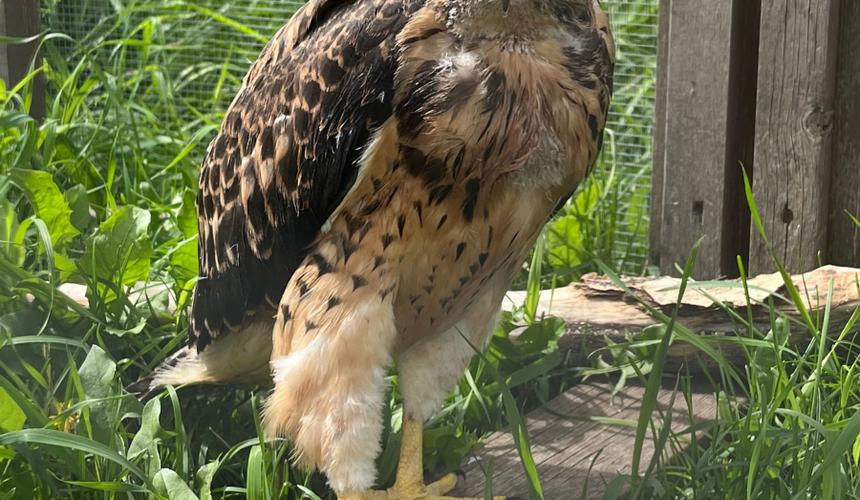Wednesday's Wildlife: Swainson's Hawk
- Calgary Wildlife
- Aug 20
- 5 min read

On a clear prairie day, you might spot them far overhead: a great spiral of birds turning in the sky like leaves caught in an invisible whirlpool. This is what is known as a kettle, a swirling flock of raptors riding columns of warm air that lift them higher and higher until they can glide for miles without a wingbeat. In Alberta, these kettles often belong to Swainson’s Hawks, one of our most well-travelled summer visitors. By August, they are gathering in these aerial whirlpools to prepare for an extraordinary migration, travelling more than 10,000 kilometres to their wintering grounds in South America.

When Swainson’s Hawks arrive in Alberta each spring, pairs settle into the wide-open prairies, hayfields, and pastures that offer plenty of hunting opportunities. Nests are often placed high in trees or on tall structures with a clear view of the surrounding grassland. The female typically lays two to four eggs, and both parents share the work of raising their chicks. Through June and July, the adults make constant hunting trips, bringing back ground squirrels, voles, mice, and even the occasional young rabbit to fuel the chicks’ rapid growth. By mid to late summer, the young are strong enough to take to the air, practicing their soaring skills in preparation for the long journey ahead.
That journey is one of the most remarkable in the bird world. As August approaches, Swainson’s Hawks gather in kettles, vast spirals of birds wheeling high overhead, a sight you might catch on a clear day if you look up. From there, their migration route carries them down through the western plains of the United States, across Mexico, and through the narrow land bridge of Central America into South America. Many follow the spine of the Andes before fanning out into the vast pampas of Argentina, Uruguay, and southern Brazil. The trip south can take weeks, with the return north in spring just as long, making their annual round trip one of the greatest migrations of any North American raptor.
Life on the South American pampas is very different from the prairie summer they leave behind. In place of mammals, Swainson’s Hawks feast almost entirely on insects: grasshoppers, crickets, dragonflies, and other large invertebrates that are abundant in the warm months. This seasonal menu shift is one of their greatest survival tools, allowing them to take advantage of whatever prey is most available, but it has also made them vulnerable. In the mid-1990s, thousands died after eating grasshoppers contaminated with the pesticide monocrotophos on Argentine farmlands. The deaths were staggering, and the species’ numbers plummeted. Thanks to international cooperation and advocacy from scientists across the Americas, Argentina banned the chemical in 1999, and mass die-offs have not been recorded since. Their recovery is a reminder that protecting a migratory bird means safeguarding it across every part of its range.

Today, Swainson’s Hawks thankfully remain a familiar sight over Alberta’s grasslands, but they aren’t the only raptors patrolling the province’s open spaces. You might spot the pale, striking Ferruginous Hawk, endangered in Alberta and built for life on the prairie, or the compact, swift Sharp-shinned Hawk darting after smaller birds along field edges. Each species has its own shape, colouring, and hunting style, and learning to spot these differences can make identifying a Swainson’s Hawk even more rewarding.
Swainson’s Hawks belong to the Buteo group, alongside Alberta’s Red-tailed, Ferruginous, Broad-winged, and Rough-legged Hawks, and at a distance, they can look quite similar. The key is in their proportions and plumage. Swainson’s tend to be slimmer than the others, with longer, narrower wings that often show a slight upward tilt when gliding. Light-morph individuals—by far the most common—have pale underwings framed by dark flight feathers and a deep, bib-like patch of colour on the chest, ranging from reddish-brown to almost black. Their heads are usually a soft brown or greyish tone, contrasting subtly with the chest.
For a quick comparison, see the guide below showing Alberta’s Buteo hawks in flight. An ID table at the end of the article highlights key features, though males, females, and juveniles may differ.

Less common but unforgettable are the dark morphs of Swainson’s Hawks, which are rich brown to nearly black all over, with only subtle contrast between their flight feathers and wing linings. Spotting one of these is a rare treat in Alberta—and one dark morph in particular has become especially well known to us at Calgary Wildlife. Lito, our resident Swainson’s Hawk, came to Calgary Wildlife in 2012 as a nestling with a severe wing injury. Unable to be released back into the wild, he became an ambassador for his species, travelling to schools and community events to help people connect with the incredible story of Swainson’s Hawks. These days, Lito enjoys a quieter life at our facility, cared for by our dedicated team, and continues to remind us of the resilience of these remarkable birds.

From the wide-open skies of Alberta to the grasslands of South America, the life of a Swainson’s Hawk is a story of endurance, adaptability, and connection across continents. Each summer they hunt, raise their young, and gather for their long journey south, filling our skies with the grace of their soaring flight. By protecting their habitats here at home and supporting conservation efforts along their migration routes, we can help ensure these hawks remain a summer presence for generations to come.
For assistance with injured and orphaned wildlife, please contact Calgary Wildlife Rehabilitation Society at 403-214-1312.
Table 1: Guide to identifying Alberta’s hawks by their underwing patterns, tail markings, leg feathering, and notable behaviors.
Species | Underwing | Tail | Legs | Notable Behaviour |
|---|---|---|---|---|
Swainson’s Hawk (Buteo swainsoni) | Pale inner wings with dark edges; no solid dark bar along the front edge | Brownish with thin stripes and a darker band near the tip | Bare yellow legs | Glides for long stretches; often seen in big swirling groups in late summer |
Rough-legged Hawk (Buteo lagopus) | Big dark patches at the “wrists” on pale wings (light form) | White base with a wide dark band at the end | Legs covered in feathers down to the toes | Can hover in one spot; only here in winter |
Broad-winged Hawk (Buteo platypterus) | Pale wings with a dark outline along the back edge | Black-and-white bands (adults); more brownish bands in young birds | Bare yellow legs | Soars in tight circles; sometimes migrates in large groups |
Red-tailed Hawk (Buteo jamaicensis) | Solid dark bar along the front edge of the wing | Adults have a solid reddish tail; young birds have brown, faintly banded tails | Bare yellow legs | Common along roadsides; slow flap–soar pattern |
Ferruginous Hawk (Buteo regalis) | Mostly pale wings; light form shows rusty “V” where legs meet body | Mostly pale, sometimes with light rust; little to no banding | Legs feathered right to the toes | Large, powerful hawk; sometimes hunts from the ground; rare and endangered in Alberta |












